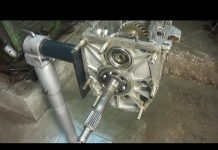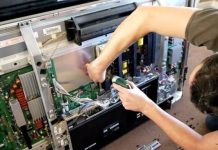Temperature control is carried out with a round wheel. It is located in the Azur iron and in other models on the body under the handle. When you turn the wheel to the right, the heating temperature increases, to the left, it decreases until the heating element is completely turned off.
The wheel acts on the thermostat by means of a special sleeve or steel angle and is attached to the body with latches. In the Scarlet iron and in other models, it is enough to pick up the adjusting disc with a screwdriver to make it come off.
The operating principle of the thermostat is based on various properties of metals.In the manufacture of this unit, two plates are soldered, made of metals with unequal coefficients of linear expansion. Thanks to these indicators, each plate behaves differently. Outwardly, it looks like this: under the influence of temperature, the common plate bends, causing the circuit to open, and the iron turns on.
To make sure that the temperature regulator is faulty, you will have to disassemble the iron completely.
The handle of the device and the plastic parts of the case are attached to the metal parts with latches or self-tapping screws. Even one manufacturer has many models, and they all have design features. But all species have common points.
To disassemble the iron, it is necessary to examine its sharp part, where there is one attachment point. For example, a Philips iron hides a self-tapping screw under the steam knob. To unscrew the screw, turn the handle all the way to the left and pull up. After removing the adjusting unit, you can unscrew the self-tapping screw. In the Brown model, the screw is hidden under the nozzle cover. You can remove the nozzle by slightly pulling it towards you. After removing it, free access to the screw opens. Other screws or latches are located under the back cover of the device.
After the plastic part of the case has been removed, the iron thermostat should be considered. In cold mode, the contacts must be closed. If there is a special device, it is better to ring the knot. If there is no device, you can clean the contacts with fine sandpaper, and then turn on the iron to the network.
To set up an iron, you can refer to statistics, which say that 50-60% of malfunctions occur due to the fact that a thermal fuse fails. This unit is disposable and reusable. Fuses of the first group, like kamikaze, are triggered only once. The unit is designed so that when the heating element reaches a temperature of 240 ° C, the circuit is broken. Further operation of the device without additional intervention becomes impossible.
More modern technologies involve the use of bimetallic parts. Such a thermal fuse is able to turn off the iron in extreme situations, and then turn it on again. If the iron does not work for this reason, the easiest way is to discard the knot and short the circuit. This can be done in different ways:
In each case, it is necessary to achieve reliable contact.
Another common ailment is a problem with the steaming system. Sometimes in the Bosch iron, the button that starts the process is strongly pressed, and steam is not supplied. Repairing a Bosch iron should begin by unscrewing the screw at the back and removing the back cover. Then you should carefully pull out the two buttons regulating the steam supply up. They are not screwed in and are held onto the bushings by friction. Next, you need to unscrew the screw, after which the plastic handle should be easily removed. There are two pumps under the cover: one supplies water to the sprinkler, the other supplies water to the soleplate to create steam. The steam pump needs to be removed. At the bottom there is a ball that sticks to the bottom of the chamber due to scale. To eliminate the malfunction, you need to push the ball into the chamber and assemble the iron in the reverse order.
Whatever iron you have to repair, you must remember about safety and follow certain rules: turn on the device to the network only when it is necessary; do not try to fix the malfunction with wet hands; during repairs, the iron must be installed on a stable, non-conductive and heat-resistant coating.
VIDEO
This topic provides a photo with explanations:
dismantling the iron,
repairing it
So, your iron has broken down at your home, no matter from which manufacturer, the question arises: "How to fix the iron."
Testing of the electrical circuit, as for all household appliances, is carried out with a probe for example OP-1
or with a digital multimeter.
There is no significant difference in the schemes of irons from different manufacturers.
For a general presentation, consider a sequential electrical circuit of connections iron Philips
The first wire of the phase or zero potential from an external power source has a plug-in connector with the terminal, from the terminal through the thermostat, the wire goes to the heating element. The second wire from the external power source has a contact detachable connection with the second terminal, from the second terminal the electric circuit has a serial connection passing through a thermal fuse and closes at the second terminal of the heating element. The control lamp and the fuse are connected in parallel to the two contact connections of the heating element.
The electrical circuit is closed on the heater - heating element and light bulb. The thermostat sets a certain temperature regime for heating the iron.
Closing and opening of the electrical circuit occurs in the thermostat itself due to a change in the bimetallic plate under the influence of the heating and cooling temperature of the heating element. The reasons for the malfunction of the iron are as follows:
a break in the cord wiring at the base of the plug;
mechanical damage to the wiring of the cord along its entire length;
burnout of the heating element of the sole of the iron;
oxidation of the contacts of the bimetallic plate of the thermostat;
blown thermal fuse
What can be replaced here during testing:
replace the cord;
replace the plug;
clean the thermostat contact;
replace the thermostat;
replace thermal fuse
Replacing the heating element in case of its malfunction, which is the sole of the iron, does not make sense, since the sole of the iron itself is more than half the cost of the iron itself. In this case, the sole of the iron is thrown away, everything else from the iron goes to spare parts. When dismantling the disassembly of the iron, care should be taken to avoid damaging the iron body.
It should be remembered that testing for detecting a malfunction of the iron is carried out in a passive way without connecting to an external power source. Immediately before connecting the iron to an external power source, it is necessary to measure the total resistance of the electrical circuit with a digital multimeter, which should not be zero on the display of the device.
Iron repair - moulinex
This topic is complemented by personal photographs and an accompanying description of the repair of the iron. As an example, consider a malfunction of the Mulinex iron.
So, before us is the Mulinex iron and the reason for its malfunction is unknown to us in advance, that is, we need to establish the exact cause of its malfunction.
In the back of the iron, photo # 1, in order to remove the cover, you need to unscrew the screw. The screw head, as you pointed out, is not suitable for our domestic screwdrivers. How to get out of the situation if there is no similar screwdriver? - Here, too, you can find a way out, for this we need small scissors with sharp ends. We insert the two ends of the scissors and we can easily unscrew the screw.
After unscrewing the screw, carefully open the cover with a screwdriver photo # 2. At the same time, we try not to damage the lid body.
After removing the back cover of the iron photo No. 3, we can see the terminal connection of the wires of the network cable with the iron elements:
heating element heating element.
Next, carefully open the lid of the iron handle with a knife, photo # 4. We put small parts from the iron handle and screws into a mug.
To directly get to the contacts of the thermostat of photo No. 5 and the heating element, or in other words - the soles of the iron, we turn off the parts one by one.
For novice specialists, you should remember the sequence of such disassembly so as not to create confusion for yourself in the further assembly of the iron.
The screwdriver in the photographs shows the attachment points for such parts.
That is, here you need to be careful about the disassembly, as it were. The body and individual parts of the iron are supplemented with fasteners such as latches.
A screwdriver shows the knob of the thermostat, photo # 7, and we need to remove one more cover, which is the heat sink of the iron plate.
The photo shows additional places of such connections, photo No. 8, we also continue to unscrew the screws and free the sole of the iron from the lid.
Well, here we got to the most interesting, so to speak - the contacts of the thermostat photo №9. The thermostat contacts are indicated with the tip of a screwdriver.
The thermostat knob sets the heating of the iron soleplate set by us. In order to prevent overheating of the heating element, the thermostat design has a bimetallic plate, which, upon reaching the preset heating temperature, disconnects the contacts. As the bimetallic plate cools down, the electrical circuit closes and the sole of the iron heats up again.
We carefully inspect the contacts of the thermostat, that is, we check this section of the electrical circuit with a probe.
For this example, the iron malfunction was the oxidation of the thermostat contacts. We clean the contacts of the thermostat with a piece of fine emery paper and once again carry out diagnostics with a probe for this area.
In addition, of course, you should also check the heating element of the iron itself.
Iron diagnostics
The photograph shows the signal lamp of photo # 10. The lamp in the electrical circuit is connected in parallel and if it burns out, this does not entail a malfunction of the iron as a whole.
In this photograph, the fingers of the hand show the contacts of the heating element of photo # 11. We carry out diagnostics of the heating element.
To do this, set the multimeter device in the resistance measurement range. With two probes of the device we touch the contacts of the heating element, on the display of the device we can see the resistance reading - 36.7 ohms.
The meter reading corresponds to the resistance of the heating element. We carry out diagnostics for the general electrical circuit of the iron photo No. 13.
We connect the two probes of the device with the pins of the plug, the result is clearly visible to us on the display of the device. That is, the resistance reading for the general electrical circuit of the iron is two tenths more.
So we figured out the malfunction and fixed the iron. As you have seen, we cannot do without diagnostics both for individual areas and for diagnosing the circuit as a whole.
Previously, the portal VashTechnik dismantled the Saturn electric kettle - I did not like it. However, the opinion of the iron is different. Also assembled Guangdong; 15 seconds after switching on, you cannot touch. The ceramic sole is equipped with 19 steam outlet holes around the perimeter, it really (corresponds to the assurances of the reviews) is excellently scratched. What to expect from a device that costs 200-300 rubles? There is a spray function. Steam operation is only possible at high sole temperatures. There are many photos below, see, admire. We decided to consider repairing the iron with our own hands, guided by the obvious reason: the Runet network is devoid of a worthwhile description of the process. Common phrases, pictures that do not shine with clarity. Today the plan is to repair the irons on their own.
Saturn is believed to be the patron saint of Saturday. Any undertakings go very badly, they turn out to be ugly, ugly. Saturn is a success in appearance, the self-cleaning function does not work well. Looking ahead, let's say: from the inside from the tank to the heating chamber there is a hole covered by a three-way nipple. The self-cleaning function corresponds to the upper position, the liquid flow is maximum. Practically inoperative. Here is a guide to the procedure:
Set the heating regulator to maximum.
Water, steam from the holes refused to pour, after disassembly it turned out: 6 out of 19 fake holes.No other word comes to mind. Made in the same style, the boiler area overlaps only the front 13. The photo of the sole is attached, you can see what you need.
The task was to understand why the self-cleaning mode does not work. Whether it is a malfunction. We are starting to disassemble the iron!
Let's start with the rear wall screw, which is not covered by anything. Difficulties will begin further. Knowing a lot about disassembling the irons, they guessed: they were still hidden by an unknown place of fastening. The screws are located under the buttons, the water inlet cover, the power regulator. In this case, the first one turned out to be the correct option. It was possible to find out by breaking one button. It can be clearly seen in the photo: each key has a pair of teeth sliding in the holes of the case, at the same time serving as limiters. It is enough to pry on the back tooth with a screwdriver, removing the button, if you don’t know in advance ... As if the plastic keys were molded brittle on purpose, there are varieties that are more elastic. We believe intentionally; trying to prevent unskilled intervention. As a result, one button (steam blow) became unusable, we will glue it with Titan, readers will have to predict the final alignment of affairs.
So, having removed two buttons, we find another screw, it is supposed to unscrew. Difficulties are not over, the handle and rear wall panel is additionally fastened with three spikes (see photo) on the spout. We cannot tell you how to properly disassemble! Finally, the cover is dismantled. Then it is simple:
The tank with pumps and steam regulator is held in place by three screws. One in the bow, two in the tail. Gently remove the soleplate temperature controller by pulling it out. Held by three pins, in a D-groove. Notice the small steel brace that secures the regulator and clicks when shifting (see photo).
The tank is pulled together, at the same time the steam shock pump path is opened. A metal tube runs through the structure, from the boiler to the pumps.
Tank, pumps of the Saturn ST - CC0211 steam iron I wanted to look at in more detail. First, look at the steam ring. Responsible for the height of the bronze rod, ending with a nipple. Through it, the water reaches the sealed soleplate tank, turning into steam. The ring is plastic, in vain. During operation, the part will begin to wear out. Consequently, the tank will gradually start to poison the water. Note:
There is no protection against water leakage from the assembly (pump, nipple stem) into the back of the handle that goes to the electrical part.
Each pump is equipped with a piston, it is possible to remove it parallel to the return spring. The sprinkler pump does not differ from the steam boost pump. You need to press both sharply, otherwise, instead of a trickle in the direction directly along the course, you get streaks that fall on the clothes. The sprinkler pump is connected to the spout nozzle, the steam shock pump is connected to a vertical steel tube that goes into the sealed container of the iron soleplate.
The indicator light is on in parallel with the heating element. A thermostat with a regulator is separated from the supply voltage. When the soleplate temperature knob rotates, the screw deflects the elastic plate up and down. The contact secured here is located above a bimetallic plate screwed to the sealed sole tank. By fine adjusting the screw position, the correct temperature is achieved. The degree of bending of a bimetallic plate is determined by heating. The relay switches with a slight click, we suppose (not tested), there may be small magnets that slightly delay the operation, making the stroke more abrupt.It is often done in a similar principle of operation of the start-up protection relays of refrigerators.
Notice the bag is visible next to the temperature control. There is a thermal fuse inside, screwed by a bracket to the sealed reservoir of the sole. The element of the electrical circuit is not soldered, seated on the clamping terminal, like a heater, is considered a major drawback of the device. By accidentally hooking a part, it is easy to disrupt the operation of the device as a whole.
From what has been said, we conclude: the inoperability of the self-cleaning system was the result of poor design thought. Checking has established: the nipple moves correctly, in the extreme position of the steam adjustment lever it reaches the upper position. Hence, the problem is caused by two reasons:
Bottom hole of the outlet of the sealed tank of the soleplate of the iron.
Poor nipple setting.
We just decided to avoid touching the device, leave it as it is for the following reasons:
The iron perfectly works out the modes, excluding self-cleaning.
The self-cleaning function can be replaced by boiling the soles of the device with a vinegar solution, no less effective (more likely - more).
Since the device works for 300 rubles, it is pointless to wish for more. The frequency of self-cleaning is not indicated, we consider the repair of the iron with our own hands complete. We will fix the key when the glue appears. Readers will be pleasantly surprised by the detailed disclosed iron device.
Most devices are designed according to the diagram. The review will help you to repair Tefal irons, repair Roventa irons, repair irons with a steam generator, and other current work. From the note, the main types of malfunctions are clear, how to eliminate:
The indicator does not light up. An open in the power supply circuit or a blown thermal fuse.
The alarm does not turn off, although the iron heats up for a long time. Temperature controller relay defective.
Water drips from the iron. The tightness of one of the pumps is broken. It is urgent to turn off the device and master the repair of steam irons.
No steam. Defective nipple, regulator wheel, or clogged water or evaporation tanks.
The iron does not heat. If the power indicator is on, the heating element has burned out. Unambiguous conclusion, because the lamp is connected in parallel.
No spray jet. The nozzle orifice is clogged, or the left pump is not properly sealed.
No steam boost, steam generation works. Sealing of the right pump is broken.
Video (click to play).
We believe that now the repair of the Tefal iron that has appeared on the horizon will not make readers faint. From what you read it is clear: the most important steps are assembly and disassembly of the iron. The repair is simple. As proof, we place a large photo of the junction of the right pump and the steam hose. Try to collect at your leisure!









